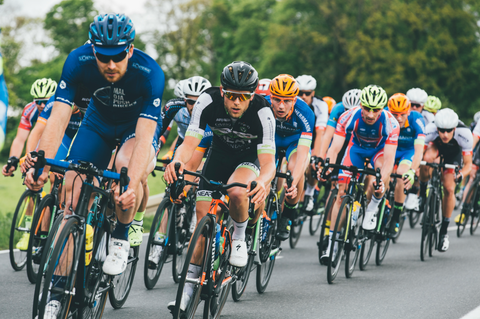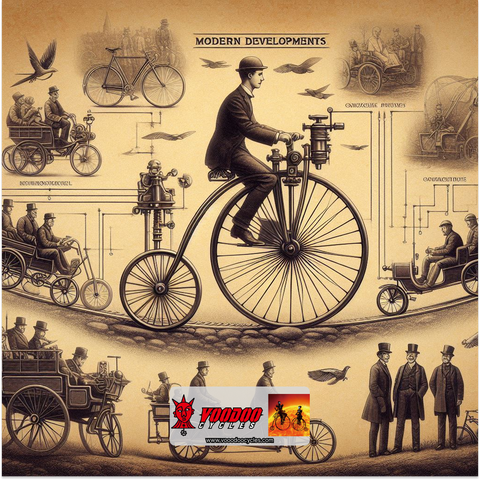
Happy Halloween Voodoo Earthlings! As Halloween approaches, many of us may be tempted to take our bikes out for a spooky night ride. While it can be a thrilling experience, it's essential to prioritize safety to ensure a fun and incident-free adventure. This article will provide you with 15 spooktacular safety tips to keep you visible, alert, and protected on your nighttime rides.
Let's dive into the details of how to stay safe and visible on your nighttime rides, so you can enjoy the thrill of the night without the fright.
Visibility:
1. Use Proper Lighting
Equip your bike with a bright front white light and a red rear light (required by law in many countries). As a general safety rule of thumb, the front light should be visible from at least 150 meters (500 feet or ≥500 lumens) and the rear light from 90 meters (300 feet or ≥300 lumens). Note that it is always important to test the amount of lighting needed in advance as environmental factors and personal preferences may effect the amount of light needed.
Bonus tip: Consider the use of flashing lights. Steady lights improve distance perception for drivers while blinking lights can increase your visibility in urban settings Research indicates that blinking or flashing lights can significantly enhance noticeability as they are hard to ignore, even in peripheral vision.
2. Wear Reflective Clothing
Wear bright and reflective clothing and gears to maximize your noticeability by standing out against dark surroundings. Reflective materials reflect incoming light instead of absorbing it. If reflective clothing is not accessible, opt for bright clothing, particularly those made from high visibility (Hi Viz) fabrics and avoid dark clothing.
Bonus tip: Consider adding reflective tape to your bike or gear to further enhance noticeability. Place to apply reflective tape includes frames, pedals, spokes, wheels, helmets, and backpack. To ensure the quality of your reflective tape, look for SOLAS reflective tape.
3. Bring Additional Lights and Battery
Bring a spare set of lights and/or battery in case of equipment failure. Better safe than sorry!
Route Planning
4. Choose Well-Lit Routes
Planning your rides on well-lit areas will minimize potential hazards. Avoid heavy traffic areas if possible. More traffic = increased unpredictability
5. Avoid Unfamiliar Areas
Unfamiliar roads, especially in the dark, can cause confusion and disorientation. Stick to routes you know well to minimize surprises and hidden hazards. Knowing the routes allows the cyclist to better anticipate potential dangers and adjust accordingly when situations arise.
6. Ride in Groups
Remember there is safety in numbers. Riding with others reduces the risk of traffic accidents as the group helps attract more attention to oncoming traffic. Other cyclists in the group can help each other keep an eye out for hazards such as potholes, debris, and more, especially when riding in unfamiliar areas.
Speed & Control
7. Ride Predictably
Maintaining a straight line while riding enhances the riders’ visibility to drivers. Abrupt changes in direction or speed can confuse oncoming traffic, increasing the risk of accidents. Avoid weaving in and out of lanes or around parked cars that will obscure you from sight.
8. Positioning on the Road
Position yourself slightly off the road's edge (approximately 70-100 cm or 2.3-3.3 feet) to increase visibility for drivers and minimize the risk of hazards like debris and potholes. This distance also improves the visibility of the bikes’ light to traffic and avoid their blind spots.
9. Maintain Safe Following Distance
By now, you probably understand that riding at night comes with its potential risks mainly due to limited visibility; increasing and maintaining the distance between you and the vehicle in front will allow for better reaction times when situations arise. It is recommended to keep a distance of at least one bike length (approximated 3-3.6 m or 10-12 feet) between riders. This spacing not only increases reaction times to sudden stops and hazards, it also prevents the blinding effect of other riders’ lights.
Other Tips
10. Be Well Rested & Stay Alert
Being well rested (both mentally and physically) can significantly improve the rider’s awareness, focus, and reaction time. In terms of mental fatigue, a recent study found that it has a significant negative effect on reaction and decision-making time in sports. On the physical fatigue side, a 2023 study found that physical fatigue negatively affects amateur athletes in both balance and reaction time. To put it in numbers, another study focusing on night time drivers, found that the mean reaction times between well-rested and very tired drivers almost doubled from 0.189 seconds to 0.309 seconds.
11. Keep Your Head Up
Stay alert for pedestrians, animals, hazards, and other obstacles that may suddenly appear in low light. When a car hits a deer at high speeds, the deer will probably be more severely injured. However, when a bicycle hits a deer at high speed, the chances of more severe injury to cyclists is higher.
12. Peak Hours Awareness
Knowing the peak hours can help the rider to anticipate when to expect more traffic. Be extra vigilant between 4 - 8 p.m. as it’s usually the rush hour when people get off work to return home; and it is also prime trick or treat time when accidents are most likely to occur involving young pedestrians. Research indicates that about 33% of bicycle-related crashes take place during afternoon rush hour periods.
13. Dress Appropriately
Wear additional layers to stay warm as temperatures can vary significantly between day and night. If rain is expected, make sure to wear reflective waterproof clothing to maintain visibility and comfort.
14. Carry a Phone and Emergency Kit
In case of emergencies, always bring a means of communication and basic tools for minor injuries and repairs while riding out at night. This is especially important if you are alone and/or riding on an unfamiliar routes.
15. Share Your Plans
Notify someone where you’re going, the route you’re taking, and when you’re expected to return especially when riding alone. If any sudden accidents happen and you become unconscious or unable to call for help, your friend or the search and rescue team will know where to start looking!
So, there you have it, Earthlings! By following these 15 spooky-good safety tips, you can confidently embark on your nighttime rides, embracing the thrill of the night without fear. Remember, a well-lit, well-equipped, and well-prepared cyclist is a safe cyclist. Happy Halloween, and safe riding! Let's cycle to Mars together!






